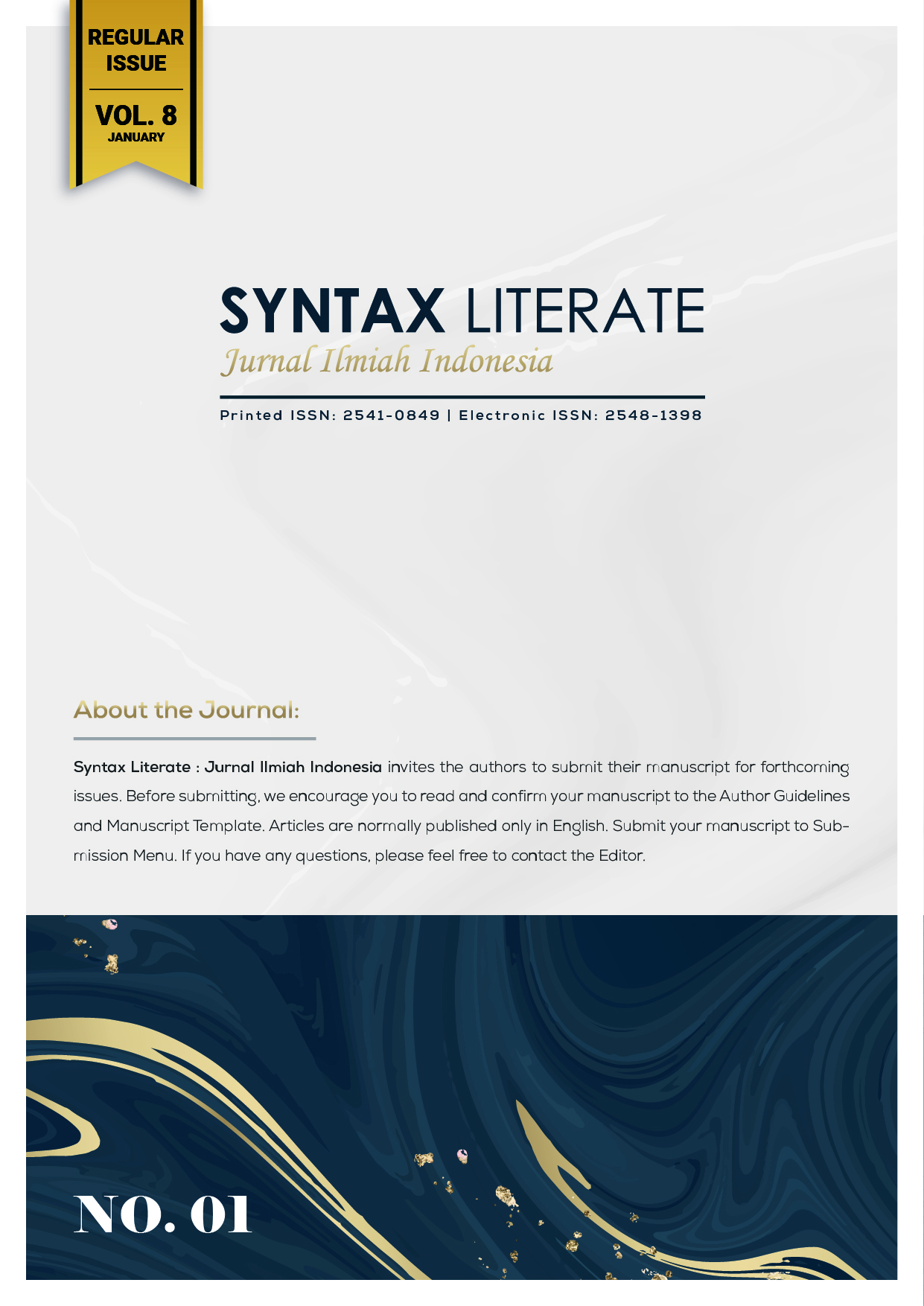Assesment Of 2012 National Health System (Skn) Detection and Curative Respond Capabilities (Covid-19 Case Study)
Abstract
Covid-19 is a new emerging disease that spreads at Indonesia in 2020. The 2012 SKN as a legislative tool that applies and plays a role in health development aims to achieve the highest level of human health in Indonesia. However, the Covid-19 pandemic has proven that the health development that has been carried out has not been able to overcome the threat of the SARS-CoV-2 virus. This is evidenced by the large number of fatalities experienced by the people of Indonesia due to infection with the SARS-CoV-2 virus. The outbreak of Covid-19 was followed by large fatalities due to massive SARS-CoV-2 virus infection throughout 2020 until early 2022. The introduction of the disease that has occurred for 2 years should have been able to be anticipated by SKN through the capabilities of the SKN component regarding efforts to detect SARS-CoV-2. CoV-2 and curative efforts against Covid-19 patients. So in this study, an effort to compare the ability of the SKN response was carried out regarding detection and curative efforts in the first year of the pandemic and the second year of the pandemic. The comparison was carried out to see how the different SKN responses to the ongoing pandemic. The results are only testing indicators on detection capabilities that have good readiness (quantity refers to the standard), while other indicators such as surveillance, hospital capacity and health workers are still in an inadequate situation. So it is necessary to strengthen the SKN in an effort to anticipate the threat of a pandemic in the future
Downloads
References
Agostino, Deborah, Arnaboldi, Michela, & Lema, Melisa Diaz. (2021). New development: COVID-19 as an accelerator of digital transformation in public service delivery. Public Money & Management, 41(1), 69–72.
Ayuningtyas, Dumilah, Haq, Hayyan Ul, Utami, Raden Roro Mega, & Susilia, Sevina. (2021). Requestioning the Indonesia government’s public policy response to the COVID-19 pandemic: black box analysis for the period of January–July 2020. Frontiers in Public Health, 9, 612994.
Baek, Yoon Gi, Lee, Yu Na, Lee, Dong Hun, Shin, Jae in, Lee, Ji Ho, Chung, David H., Lee, Eun Kyoung, Heo, Gyeong Beom, Sagong, Mingeun, & Kye, Soo Jeong. (2021).
Multiple reassortants of H5N8 clade 2.3. 4.4 b highly pathogenic avian influenza
viruses detected in South Korea during the winter of 2020–2021. Viruses, 13(3), 490.
Basile, Carlo, Combe, Christian, Pizzarelli, Francesco, Covic, Adrian, Davenport, Andrew, Kanbay, Mehmet, Kirmizis, Dimitrios, Schneditz, Daniel, Van Der Sande, Frank, & Mitra, Sandip. (2020). Recommendations for the prevention, mitigation and containment of the emerging SARS-CoV-2 (COVID-19) pandemic in haemodialysis centres. Nephrology Dialysis Transplantation, 35(5), 737–741.
Basile, Luigi Jesus, Carbonara, Nunzia, Pellegrino, Roberta, & Panniello, Umberto. (2023). Business intelligence in the healthcare industry: the utilization of a data-driven approach to support clinical decision making. Technovation, 120, 102482.
Brake, Samuel James, BarnslAey, Kathryn, Lu, Wenying, McAlinden, Kielan Darcy, Eapen, Mathew Suji, & Sohal, Sukhwinder Singh. (2020). Smoking upregulates angiotensin-converting enzyme-2 receptor: a potential adhesion site for novel coronavirus SARS-CoV-2 (Covid-19). Journal of Clinical Medicine, Vol. 9, p. 841. MDPI.
Cahyani, Inswasti, Putro, Eko W., Ridwanuloh, Asep M., Wibowo, Satrio, Hariyatun, Hariyatun, Syahputra, Gita, Akbariani, Gilang, Utomo, Ahmad R., Ilyas, Mohammad, & Loose, Matthew. (2022). Genome profiling of SARS-CoV-2 in Indonesia, ASEAN and the neighbouring East Asian Countries: features, challenges and achievements. Viruses, 14(4), 778.
Chartier, Yves. (2014). Safe management of wastes from health-care activities. World Health Organization.
Chavan, Shraddha, & Shinde, D. K. (n.d.). Development of Scheduling Optimization Tool using Excel VBA and Solver for Productivity Improvement of Slitting Machines for PVC/PVDC Film.
Dinar, Yassinta Ben Katarti Latiffa. (2022). THE EFFICIENCY OF THE NATIONAL ECONOMIC RECOVERY PROGRAM IN WITHSTANDING THE IMPACT OF THE COVID-19 PANDEMIC. Jurnal Litbang Sukowati: Media Penelitian Dan Pengembangan, 6(1), 68–83.
Gupta, Kuhika. (2012). Comparative public policy: Using the comparative method to advance our understanding of the policy process. Policy Studies Journal, 40, 11–26.
Khare, Shruti, Gurry, Céline, Freitas, Lucas, Schultz, Mark B., Bach, Gunter, Diallo, Amadou, Akite, Nancy, Ho, Joses, Lee, Raphael T. C., & Yeo, Winston. (2021). GISAID’s role in pandemic response. China CDC Weekly, 3(49), 1049.
Ling-Hu, Ted, Rios-Guzman, Estefany, Lorenzo-Redondo, Ramon, Ozer, Egon A., & Hultquist, Judd F. (2022). Challenges and Opportunities for Global Genomic Surveillance Strategies in the COVID-19 Era. Viruses, 14(11), 2532.
Moore, Tricia S., Lapan, Stephen D., & Quartaroli, MaryLynn T. (2012). Case study research. Qualitative Research: An Introduction to Methods and Designs, 37, 243–270.
Organization, World Health. (2013). Guidelines for second generation HIV surveillance: An update: Know your epidemic.
Sucahya, Purwa Kurnia. (2020). Barriers to covid-19 RT-PCR testing in Indonesia: a health policy perspective. Journal of Indonesian Health Policy and Administration, 5(2).
Suwartawan, Dedy, & Ariani, Rospita. (2022). Dengue Prevention In Gilimanuk Port Buffer Area During The Covid-19 Pandemic. PROCEEDING BOOK OF INTERNATIONAL SCIENTIFIC MEETING ON EPIDEMIOLOGY (ISME), 90.
Tawai, Adrian, Suharyanto, Agung, Putranto, Teguh Dwi, de Guzman, Broderick M. N., & Prastowo, Ari Agung. (2021). Indonesian covid-19 issue on media: review on spiral of silence application theory. Jurnal Studi Komunikasi, 5(2), 286–301.
Copyright (c) 2023 Rendy Setya Wardana, Isroil Samihardjo, Ede Surya Darmawan

This work is licensed under a Creative Commons Attribution-ShareAlike 4.0 International License.











